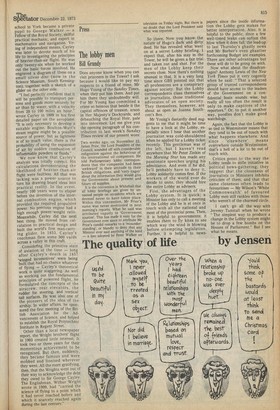Science
Before the Wiights
Bernard Dixon
Everyone knows about the Wright brothers, Orville and Wilbur, who flew the world's first aeroplane at Kitty Hawk, North Carolina, seventy years ago this week. But who remembers Sir George Cayley — a name equally if not more important in the history of aviation — whose anniversary also falls this month? Although Cayley, who was born on December 27. 1773, never achieved his aim of powered flight, his calculations and experiments showed that this was a feasible proposition. Decades before its time, his work was Just as significant as its later fulfilment by the Wright brothers.
For many centuries before Cayley, inventors and enthusiasts bent on flying had been obsessed with the need to imitate birds. Even Leonardo da Vinci, who helped to develop the idea of the helicopter, believed that the answer to powered flight was to construct wings that flapped like those of a bird. Such attempts were, of course, doomed to failure. The real answer was to be found by examining the kite, which derives 'lift' from the pressure of • rushing air as It is pulled forward. As long as this lift is greater than the weight of the kite (or aeroplane), and the thrust pulling it forward exceeds the drag caused by air resistance, the craft will fly. It was these principles which Cayley studied and described for the first time, and in considerable detail.
George Cayley was born at Scarborough, and after attending
Sf.ètator December. 22, 1973
school in York became a private pupil to George Walker — a Fellow of the Royal Society, skilful practical mechanic, and expert in mathematics and navigation. Veing of independent means, Cayley was later to devote much of his life to investigating the principles of heavier-than-air flight. He was only twenty-six when he worked out the basic forces involved. He engraved a diagram of these on a small silver disc (now in the Science Museum, South Kensington), together with a sketch of a glider on the other side. •
"I feel perfectly confident that it will be possible to transport persons and goods more securely by air than by water, with a velocity from 20 to 100 miles an hour," wrote Cayley in 1809 in his first detailed paper on the aeroplane. "It is only necessary to develop a suitable engine. Boulton-Watt's steam engine might be a possible source of power, but as lightness is of so much value, there is the probability of using the expansion of air by sudden combustion of inflammable powders or fluids." We now know that Cayley's analysis was totally correct. His calculations demonstrating the likelihood of heavier-than-air flight were faultless. All that was lacking was a power source to turn his drawing board ideas into practical reality. In the event, nearly 100 years were to elapse before the invention of the internal combustion engine, which provided the required propulsive power. No previous engine had a high enough power/weight ratio. Meanwhile, Cayley did the next best thing. He moved from calculation to practical design and built the world's first man-carrying glider. In 1853, Cayley's coachman flew some 500 yards across a valley in this craft.
Considering the primitive sta-te of aviation at the time — long after Cayley's•death in 1857 'winged locomotives' were being built that had no chance whatever of flying — Cayley's theoretical work is quite staggering. As well as working out the fundamental principles of powered flight, he formulated the concepts of the airscrew, rear elevators, the rudder for steering, and vertical tail surfaces. He was also one of the pioneers of the idea of the airship. In wider affairs, he sponsored the first meeting of the British Association for the Advancement of Science, and helped to establish the Royal Polytechnic Institute in Regent Street.
Other than a local newspaper report, the Wright brothers' flight' in 1903 created little interest. It took two or three years for their momentous achievement to be recognised. But then, suddenly, they became famous and were mobbed and lionised wherever they went. All the more gratifying, then, that the Wrights went out of their way to acknowledge the debt they owed to Sir George Cayley. The Englishman, Wilbur Wright wrote in 1909, had "carried the science of flying to a point which it had never reached before and which it scarcely reached again during the last century."



































 Previous page
Previous page